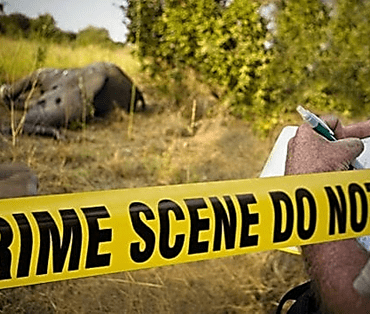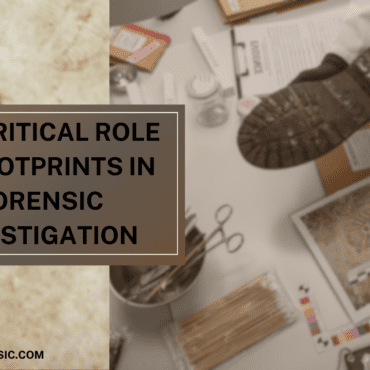What is wildlife forensics?
Fig. 1: Wildlife Crime Scene Investigation
‘Wildlife’ generally refers to animals and plants found in the wild, not domesticated or cultivated. The term encompasses species naturally occurring in their habitats, as opposed to those brought into captivity and selectively bred over time.
‘Forensic,’ derived from Latin meaning ‘public,’ pertains to matters of law.
‘Wildlife Forensics’ utilizes forensic science to protect and conserve non-domesticated animals, including those in natural habitats and captivity, as well as plants and their ecosystems.
‘Wildlife crime’ refers to offences threatening wild animals, plants, or habitats, breaching national, regional, or international laws. This includes crimes involving domesticated species, such as animal cruelty cases or using animals as evidence in criminal investigations.
Scope of Wildlife Forensics
Legal disputes involving wild animals, whether they are in their natural habitats or kept in captivity, are becoming more common across various regions, including Europe, North and South America, Australasia, Africa, India, and the Far East. Consequently, these animals may also be subjected to forensic examination.
Wild animals (free-living or captive) are involved in legal cases in three main ways
- Be the cause of an incident – for example, if they injure a person, damage property, or spread an infectious disease.
- Be the victim – an animal that is killed, injured, poached, illegally exported, or subjected to inhumane treatment.
- The animal is discovered dead under circumstances that are unusual, unexpected, or suspicious.
- The animal is alive, but its symptoms appear to be abnormal, unexpected, or suspicious.
- The animal’s welfare is currently or has been compromised.
- There are indications that the animal has been unlawfully captured, killed, or held in captivity.
- Provide information that is relevant to an incident – for example, because they were present when a crime was committed and their hair or other material remains as evidence.
Animals of different species, alone or in groups, have the potential to inflict injuries, cause death, and result in financial losses. Wildlife forensic cases may involve wild animals, domesticated animals, and humans. E.g., a pet dog may be responsible for killing or maiming a protected species.
Methods in Wildlife Forensics
The methods utilized in wildlife forensics closely resemble those employed in other criminal investigations. Typically, forensic cases in this field involve a combination of the following methods:
- Inspecting the alleged crime scene and evaluating any findings or observations.
- Gathering information primarily through interviews with individuals involved in or related to the incident.
- Examining live animals.
- Inspecting deceased animals.
- Gathering and identifying evidence, including derivatives and samples, for laboratory analysis. This may involve a certain amount of fieldwork.
- Ensuring proper transportation of specimens to the laboratory for analysis.
- Conducting laboratory tests.
- Properly storing and presenting evidence.
- Generating reports based on findings.
- Providing expert testimony in court.
- Preserving materials for potential further legal proceedings or for future reference.
The Tools of the Trade
In wildlife investigation, a range of forensic techniques are employed to gather evidence and uncover the mysteries surrounding crimes involving animals. Some key methods and how they are adapted to wildlife cases are below:
- DNA Analysis: DNA analysis extracts genetic material from samples like blood, hair, feathers, or feces to identify species, individuals, or genetic traits. Crucial in wildlife cases, it helps trace the origins of confiscated items, identify endangered species in illegal trade, and link suspects to crimes.
- Fingerprinting: Fingerprinting analyzes unique patterns to identify individuals. In wildlife cases, experts use techniques like footprint analysis to identify species and link suspects to crime scenes. Comparing footprint impressions from poaching sites can reveal both perpetrators and species involved.
- Chemical Analysis: Chemical analysis tests samples for toxins, pesticides, or pollutants. In wildlife cases, it determines causes of death, assesses pollution impacts on wildlife health, and identifies illegal substances in poaching. For instance, analyzing lead in scavenging bird tissues identifies lead poisoning from ingesting ammunition fragments.
- Other Methods
Pathology: Examining tissues and organs to diagnose diseases, injuries, or trauma in wildlife.
Isotope Analysis: Determining the geographic origin, diet, and migration patterns of wildlife based on stable isotopes in tissues.
Geospatial Analysis: Using GIS and satellite imagery to map habitats, track animal movements, and detect illegal activities like deforestation or habitat destruction.
Forensic Entomology: Studying insect colonization on carcasses to estimate the time of death and gather evidence in wildlife crime scenes.
Case Studies: Real-life Wildlife Crime Investigations
Real-life case studies showcasing wildlife crime investigations
Operation Crash
- Location: United States
- Summary: Led by the U.S. Fish and Wildlife Service (USFWS), Operation Crash targeted rhinoceros horn trafficking. It utilized undercover operations, surveillance, and forensics to dismantle smuggling networks.
- Key Findings: Forensic analysis, including DNA and isotopic analysis of seized horns, linked them to poaching incidents, aiding in identifying smuggling routes.
- Outcome: Operation Crash led to arrests, prosecutions, and policy reforms, increasing penalties for wildlife trafficking and raising awareness about rhino conservation.
Fig. 2: Rhinoceros Horn Trafficking
Tiger Poaching Case in India
- Location: India
- Summary: Wildlife forensics proved crucial in convicting tiger poachers. DNA analysis linked seized tiger parts to specific incidents, aiding convictions.
- Key Findings: DNA matching confirmed poaching, securing convictions, and disrupting trafficking networks.
- Outcome: Successful prosecutions deterred tiger poaching, emphasizing wildlife forensics’ role in conservation law enforcement and species protection.
Fig. 3: Tiger Poaching Case
Elephant Ivory Trafficking Case
- Location: Africa and Asia
- Summary: An international investigation into illegal elephant ivory trade threatening African and Asian elephants. Forensic analysis determined the origin, age, and DNA profiles of seized ivory.
- Key Findings: Isotopic analysis traced origins, aiding in identifying smuggling routes. DNA matching facilitated prosecutions and disrupted illegal networks.
- Outcome: Arrests and prosecutions of offenders, increased awareness about ivory poaching’s impact, and spurred global anti-trafficking efforts to protect elephant populations.
Fig. 4: Elephant Ivory Trafficking
Pangolin Trafficking Bust
Location: Southeast Asia
Summary: Coordinated law enforcement operation targets pangolin trafficking, driven by demand for scales in traditional medicine, threatening the world’s most trafficked mammal.
Key Findings: Forensic analysis identifies species, and origins of seized scales; DNA links them to poaching incidents and pangolin populations.
Outcome: Arrests and prosecutions disrupt trafficking, safeguard pangolins. The case underscores wildlife forensics’ role in law enforcement and conservation against illegal wildlife trade.
Fig. 4: Pangolin Trafficking
Current trend of wildlife crime in India
Some of the key points regarding the current trend of wildlife crime in India.
- Poaching and Illegal Wildlife Trade: Persistent threats to species like tigers, elephants, rhinos, and pangolins due to high demand for their parts.
- Human-Wildlife Conflict: Increasing instances of conflict due to habitat encroachment, leading to property damage and attacks on humans by animals.
- Illegal Logging and Habitat Destruction: Rampant deforestation and habitat loss endanger many species, particularly in protected areas.
- Online Wildlife Trafficking: Growing use of the internet and social media for illegal trade, posing challenges for law enforcement.
- Organized Crime Networks: Involvement of sophisticated criminal syndicates exacerbates enforcement challenges.
- Species-Specific Threats: Certain species face targeted threats; for instance, the Indian rhinoceros is particularly vulnerable due to the demand for its horn in traditional medicine.
- International Trafficking Routes: India serves as a significant transit point for the illegal wildlife trade, with traffickers exploiting porous borders and well-established smuggling routes.
- Demand for Traditional Medicines: Persistent demand for wildlife products in traditional medicine systems drives poaching and illegal trade, despite legal protections and awareness campaigns.
Ethical Considerations and Challenges
Balancing justice and conservation goals in wildlife forensics, navigating ethical complexities of sample collection, invasive techniques, and minimizing harm to ecosystems and animals.
- Jurisdictional Issues and Resource Constraints
Wildlife crime’s cross-border nature requires legal harmonization, while limited resources hinder investigations, especially in developing nations, worsening challenges in combating illegal activities effectively.
- International Cooperation
Wildlife trafficking’s global reach necessitates collaboration among law enforcement agencies, overcoming differences in legal systems and prioritizing capacity-building initiatives to enhance forensic capabilities worldwide.
- Balancing Justice with Conservation Goals
Striking a balance between deterrence and rehabilitation in wildlife crime punishment, engaging communities for sustainable conservation, fostering stewardship, and addressing root causes like poverty and governance weaknesses.
Application of Forensic Science to wildlife investigations
Forensic methods, commonly associated with crime investigation, have diverse applications beyond criminal justice. Here’s how they are utilized in various domains:
- Inquests: Forensic methods are crucial in ascertaining the cause of death during inquests Through autopsies, toxicology tests, and analysis of physical evidence, forensic experts assist coroners in establishing the circumstances surrounding a death.
- Malpractice Hearings: Forensic analysis is crucial in malpractice hearings, especially within medical, legal, and financial domains. It involves scrutinizing evidence to determine if professional negligence or misconduct occurred, aiding in fair adjudication.
- Insurance Claims: Insurance companies utilize forensic techniques to probe suspicious claims, including instances of arson or fraudulent accidents. Analysis of physical evidence, examination of documents, and reconstruction of events help in verifying the validity of claims.
- Environmental Impact Assessments: Forensic science contributes to environmental assessments by analyzing pollutants, contaminants, and ecological damage. This aids in identifying sources of pollution, assessing environmental risks, and developing mitigation strategies.
- Governmental and Other Inquiries: Forensic experts are often called upon to provide evidence and expertise in governmental inquiries, commissions, or public hearings. They assist in investigating complex issues, ranging from public safety concerns to financial irregularities.
- Trading Standards: Forensic methods are utilized in verifying product authenticity, detecting counterfeit goods, and ensuring compliance with quality standards. This helps protect consumers from fraudulent practices and maintains market integrity.
- Inspection of Pet Shops, Boarding Establishments, and Zoos: Forensic techniques are applied in animal welfare inspections to assess the health, living conditions, and treatment of animals in commercial establishments like pet shops, boarding facilities, and zoos. Examination of animal remains, environmental conditions, and documentation aids in ensuring compliance with regulations and ethical standards.
Looking Ahead: The Future of Wildlife Forensics
- Technological Advancements: Improved forensic techniques and portable DNA analysis tools will enhance investigation efficiency.
- Big Data and AI: The utilization of big data and AI algorithms will enable better crime prediction and enforcement targeting.
- Interdisciplinary Collaboration: Collaboration between forensic scientists, biologists, and law enforcement will drive innovation.
- Capacity Building: Training programs and resource allocation will strengthen forensic capabilities in developing countries.
- Policy and Legal Reforms: Strengthening wildlife protection laws and international cooperation will deter offenders.
- Public Engagement: Increasing awareness and education will mobilize support for conservation efforts and ethical behaviour.
- Ethical Considerations: Guidelines and protocols will ensure ethical conduct in wildlife forensic investigations.
Conclusion
Wildlife forensics plays a crucial role in protecting biodiversity, combating illegal wildlife trade, and enforcing conservation laws. Despite encountering obstacles, the field provides substantial benefits in crime detection, species identification, evidence-driven conservation, deterrence, and global collaboration.
Efforts to address these challenges require sustained investment in forensic capacity-building, policy reform, public engagement, and ethical stewardship. By strengthening collaboration between forensic scientists, conservationists, law enforcement agencies, and local communities, we can harness the full potential of wildlife forensics to safeguard wildlife populations, preserve ecosystems, and uphold justice for future generations. Through collective action and commitment to ethical principles, we can overcome the obstacles and realize the promise of wildlife forensics in securing a sustainable future for our planet’s biodiversity.
References
- Sahajpal, V., Mishra, S. and Bhandari, D. (2021). Forensic Analysis in Wildlife Crime Cases: Microscopy, DNA Profiling and Isotope Analysis. [online] www.intechopen.com. IntechOpen. Available at: https://www.intechopen.com/chapters/77090.
- Rana, A.K. and Kumar, N. (2023). Current wildlife crime (Indian scenario): major challenges and prevention approaches. Biodiversity and Conservation. doi:https://doi.org/10.1007/s10531-023-02577-z
Image sources












Post comments (0)